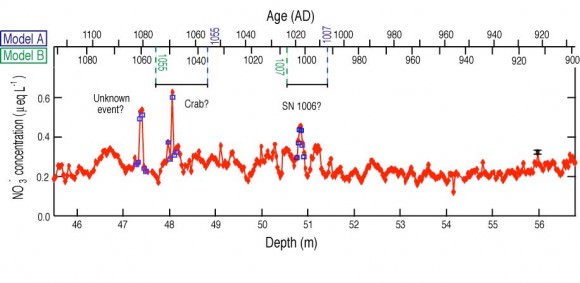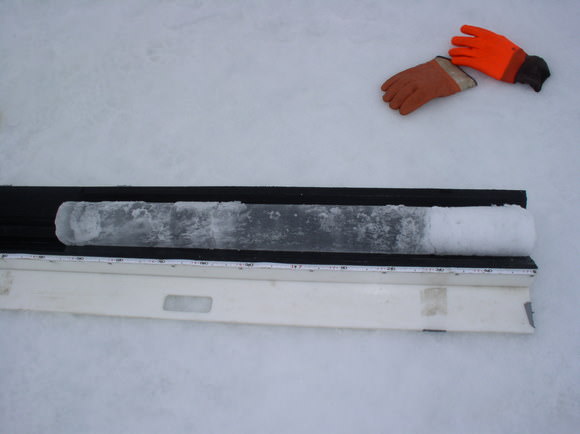[/caption]
Chinese and Arabic astronomers left historical documentation of a supernova that occurred in our own galaxy in the year 1006 (SN 1006), and another one 48 years later (SN 1054). Some of the writings about SN 1006 say there was a visual explosion half the size of the moon, and it shone so brightly that objects on the ground could be seen at night. We know these writings weren’t just fantastical imaginations because we now have the “leftovers” of these supernovae; Supernova Remnant 1006 and the Crab Nebula. But now there is more evidence. A team of Japanese scientists has found the first evidence of supernovae in an ice core sample.
The gamma rays from nearby supernova ought to have a significant impact on our atmosphere, in particular by producing an excess of nitrogen oxide. Ice cores are known to be rich in information regarding past climates, and scientists thought core samples could record astronomical phenomena, as well. In 1979, a group of researchers suggested the idea when they found nitrate ion (NO3-) concentration spikes in an ice core sample from the South Pole ice core that might correlate with the known historical supernovae Tycho (AD 1572), Kepler (AD 1604), and SN 1181 (AD 1181). Their findings, however, were not supported by subsequent examinations by other researchers using different ice cores, and the results remained controversial and confusing.
But in 2001, a team of scientists from Japan drilled a 122 meter ice core sample at the Dome Fuji station in Antarctica, an inland site in Antarctica. At a depth of about 50 metres, corresponding to the 11th century, they found three nitrogen oxide spikes, two of which were 48 years apart and easily identifiable as belonging to SN 1006 and SN 1054. The team speculates that the mysterious third spike may have been caused by another supernova, visible only from the southern hemisphere.

Additionally, the team saw a 10 year variation in the background levels of nitrogen oxide, almost certainly caused by the 11-year solar cycle, an effect that has been seen before in ice cores. This is one of the first times that a distinct 11-year solar cycle has been observed for a period before the landmark studies of sunspots by Galileo Galilei with his telescope.
They also saw a number of sulphate spikes from known volcanic eruptions such as Taupo, New Zealand, in 180 AD and El Chichon, Mexico, in 1260 AD.
The team said that by further extending their analysis to deeper and shallower ice cores would give fruitful information on galactic supernova and solar activity histories, and they are now in the process of making ionic measurements covering the past 2,000 years, including analyses of all known historical supernovae and solar periods.
Sources: arXiv, arXiv Blog


I’ve read many articles about the SN1006, it was low in the southern sky as seen from China and Arabic countries, and had to be awfully bright dispite atmospheric dimming due to being low on the horizon. This had to be a class 1A type SN, when I try to get info on the distance, I get conflicting distances, form 2k-5k LY away. Betelgeuse, as this is relatively close, should this collapse and explode, I understand could be as brilliant as
the Moon, however, it will remain a point of light and can hurt the eyes looking at this for more than a few seconds, perhaps Betelgeuse will explode in a million years or tonight!!! No one knows!
This is an interesting article how SN1006 although 2k-5k LY away, still had an impact on our atmosphere. I’ve read various articles about should Betelgeuse explodes, enough
neutrinos and charged particles will get though our atmosphere and damage severe
enough human tissues and DNA and kill 1/100th of our population from Cancer, the type that affects the whole body quickly,this is
60million people!!! There are various reports that 6million die yearly from Cancer that affects the whole body, although there was no history of cancer in the family or in a cancerous environment, these are the ‘strange’ cancer cases that doesn’t start from a certain area of the body but affects the whole body quickly and the person dies relatively quickly- these 6million are just victims of the natural cosmic rays and UltraHighPowerCosmicRays that hits humans. I am always amazed how much power the Universe has, we all are having 100M neutinos passing through us every secondth, amazing.!!!
It’s amazing to see tangible traces of supernovae being found on Earth itself.
Only a couple of little pieces left to figure out. How long did it take for these gamma rays to travel to earth? and How long did it take for the nitrates to form and then precipitate?
Altogether a very interesting topic.
the_nthian , it is not relevant how long did it take for gamma rays to arrive – they arrived at the same instant as their light, that means in 1006 and 1054, and this depends on how far away were the SN’s…
I meant, the travel time depended on SN’s distances, sorry 🙂
Gotta love science!
Stuff like this is more interesting and grand than any ancient myth.
Probably these explosions are the basis for some interesting myths in some countries…a good possibility!!!
Yes, good point, Vino. In fact, I bet most of our earthly “Viracocha” type beliefs are probably derived from regular or more exotic space events that occured at some point in the past.
I bet most of us would love to witness such an event, but unfortunately our lives are but a picosecond in the endless flow of time. “It could explode tonight or in a million years” is a testament to that 🙂
Amazing that they had ice deep enough to drill into to a depth of 50 ft. given that the polar caps have melted from global warming and setting the polar bears adrift. And now they think they’ll drill deeper?! That’ll be a neat trick. Science is awesome.
Yeah Dave it sure is man.
I like reading stuff like this.
Skeeter,
The ice is several miles thick in places. It was that thick over the Northern UK during the last ice age. Greenland ice is about 10,000 feet thick and is why if it melts world sea levels will rise about twenty feet.
One thing: where are the deposits of heavy metals from SN’s?????
Question, can the remnants thrown off so rapidly and travel so quickly through space affect the genetics of humans on Earth?
Chris;
This is just a guess, but I would be willing to bet that the heavy metals, being massive particles, are stopped before getting to earth, by a gas or dust cloud, for example. Gamma rays, on the other hand, are unaffected by most interstellar obstacles. Also, it may be possible (and this is just speculation) that their concentrations are too low to register above the background. A lot more gamma radiation is produced than heavy metal nuclei, meaning that heavy metal concentrations are already much lower than gamma ray concentrations. This alone might be enough to keep heavy metal readings below the background, or it might be a combination; some heavy metals are blocked by ust, and the reduced number that get through are too few to register.
Anyways, all of that is speculation, but it seems to make sense to me.
Any metals would have mass and therefore would not travel at near the speed of the energy put off by the supernovea. I am more curious as to what can be found out about the earlier spike however.
Would this discovery further validate the perspective that mankind’s role in contributing to global warming is minimal when compared to natural phenomena? Or is there any indirect inference to global climatic changes (ie: warming) with regard to this discovery? Thanks.
i’m sure al gore will find a way to spin this to show that humans are to blame for SNs
Recent MaxPlank *.sat observations seem to indicate that that higher energy or gamma ray shockfronts may travel faster than lesser energetic EM pulses. The real question is whether or not those high energy gamma ray bursts actually were measured traveling faster than light, implying an extra-dimensional influencing medium.
“that that”? sheesh , my fingers appear to be traviling a little bit in front of themselves also.
Oops.. Fermi Gamma Ray Telescope.. not the Max Plank scope which I was just reading about prior to… oh nevermind.
In lieu of the comments so far made, the gamma rays and neutrinos arrive first, followed by the EM pulse, then the visual rise in brightness.
The reason for the delay has little to do with the medium, but is caused by the supernova formation process. The reaction is started by the collapse of the core, which when reaching the maximum compression, immediately releases the high-energy gamma ray photons and the neutrinos over about 0.3 seconds.
After the core bounces, the catastrophic event releases the remaining radiation back into surrounding space. This shell is at first opaque, but as the shell expands, the higher frequencies radiate in turn from expanding material.
Maximum visual brightness is only reached within a day or two later.
What is terrifying is the irradiation occurs without warning and has no possible warning system (save predicting the actual core collapse, which is presently beyond our capabilities.)